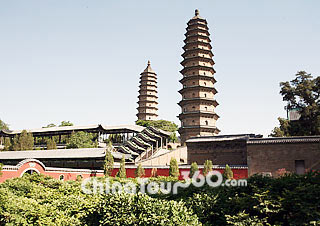 Taiyuan Double Pagoda Temple
Taiyuan Double Pagoda Temple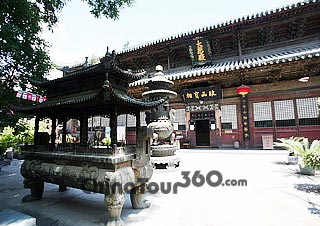 Chongshan Temple
Chongshan Temple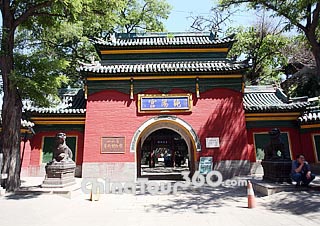 Chunyang Palace
Chunyang Palace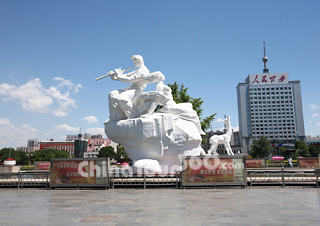 Taiyuan City
Taiyuan City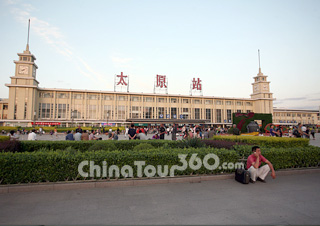 Taiyuan Railway Station
Taiyuan Railway Station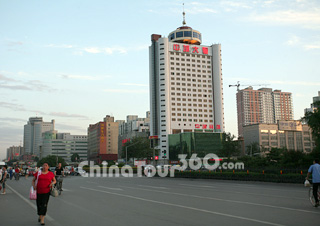 Taiyuan Street Scene
Taiyuan Street Scene
![]() Facts
Facts
Phone Code: 0351
Postal Code: 030001
Area: 6,988 Sq km (2,698.1Sq miles)
Population: 4,336,000 (in 2010)
Nationalities: Han, Hui
Neighboring Areas: Hebei, Henan, and Shaanxi Provinces; Inner Mongolia Autonomous Region
Location: At the northern end of the Loess Plateau, Taiyuan is located in the central part of Shanxi Province, lying between 111°30'-113°09' east longitude and 32°27'-38°27' north latitude.
![]() Physical Features: The landform is like a dustpan, surrounded by mountains in the north east and west and occupied by valley plains in the center and south. Fenhe River, a main branch of the Yellow River, flows through Taiyuan from west to east.
Physical Features: The landform is like a dustpan, surrounded by mountains in the north east and west and occupied by valley plains in the center and south. Fenhe River, a main branch of the Yellow River, flows through Taiyuan from west to east.
![]() History: Having more than 2,500 years history, it was once the capital city of the Zhao State during the Warring States Period (476 - 221BC). The emperors of the Tang Dynasty (618 - 907) expanded Jinyang City (present Taiyuan) several times, and had conferred it as 'north capital', then known as the 'Three Capitals' together with Chang'an and Luoyang at that time. In the Ming (1368 - 1644) and Qing (1644 - 1911) dynasties, it developed fast in mineral, business and handcraft industries, enjoying fame as 'Taiyuan businessmen become the leader of the national economy'.
History: Having more than 2,500 years history, it was once the capital city of the Zhao State during the Warring States Period (476 - 221BC). The emperors of the Tang Dynasty (618 - 907) expanded Jinyang City (present Taiyuan) several times, and had conferred it as 'north capital', then known as the 'Three Capitals' together with Chang'an and Luoyang at that time. In the Ming (1368 - 1644) and Qing (1644 - 1911) dynasties, it developed fast in mineral, business and handcraft industries, enjoying fame as 'Taiyuan businessmen become the leader of the national economy'.
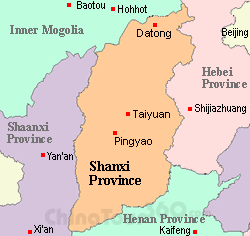 |
| Taiyuan Maps |
![]() Attractions: As the north gate of China, Taiyuan was always the point of battle in ancient China, having numberless historical sites. Among them, there are old grottoes like the largest Daoist grottoes in China - Longshan Grottoes and Yungang Grottoes, temples of different religions - Buddhist temple Chongshan Monastery and Daoist temple Chunyang Palace. Besides, Jinci Temple represents the architecture, sculpture and aesthetic standard of the Song Dynasty (960 - 1279); the twin pagodas in the Twin Pagoda Temple has become the symbol of the city; Wutai Mountain in the north and Niangziguan Great Wall in the east also have a long history and are very famous.
Attractions: As the north gate of China, Taiyuan was always the point of battle in ancient China, having numberless historical sites. Among them, there are old grottoes like the largest Daoist grottoes in China - Longshan Grottoes and Yungang Grottoes, temples of different religions - Buddhist temple Chongshan Monastery and Daoist temple Chunyang Palace. Besides, Jinci Temple represents the architecture, sculpture and aesthetic standard of the Song Dynasty (960 - 1279); the twin pagodas in the Twin Pagoda Temple has become the symbol of the city; Wutai Mountain in the north and Niangziguan Great Wall in the east also have a long history and are very famous.
![]() Transportation:
Transportation:
![]() Air: Taiyuan Wuxu International Airport has direct flights to almost all of the large and medium-sized cities such as Beijing, Tianjin, Shanghai, Xian, Guilin and Shenyang, and foreign cities like Frankfort, Paris, London, New York, Singapore and Kuala Lumpur.
Air: Taiyuan Wuxu International Airport has direct flights to almost all of the large and medium-sized cities such as Beijing, Tianjin, Shanghai, Xian, Guilin and Shenyang, and foreign cities like Frankfort, Paris, London, New York, Singapore and Kuala Lumpur.
![]() Train: Taiyuan Railway Station is the terminal of Beijing-Taiyuan and Shijiazhuang-Taiyuan railways, and the starting point of Taiyuan-Jiaozuo railway, connecting dozens of Chinese cities.
Train: Taiyuan Railway Station is the terminal of Beijing-Taiyuan and Shijiazhuang-Taiyuan railways, and the starting point of Taiyuan-Jiaozuo railway, connecting dozens of Chinese cities.
![]() Bus: There are many long-distance bus stations in the city. Yinze Street Bus Station mainly operates buses to the cities outside of Shanxi Province, and tourism buses to Wutai Mountain, Hunyuan Xuankong Temple and Yingxian Wooden Pagoda; Taiyuan Long-distance Bus Station has buses to the cities and areas inside and outside Shanxi Province, and direct buses to Pingyao Old City; the East Bus Station is for the buses to Xinzhou and Shuozhou, and Yingbing Road Bus Station's buses are mostly to Linfen. In the city, there are around 200 bus routes to the major scenic spots, local districts as well as the nearby suburban counties.
Bus: There are many long-distance bus stations in the city. Yinze Street Bus Station mainly operates buses to the cities outside of Shanxi Province, and tourism buses to Wutai Mountain, Hunyuan Xuankong Temple and Yingxian Wooden Pagoda; Taiyuan Long-distance Bus Station has buses to the cities and areas inside and outside Shanxi Province, and direct buses to Pingyao Old City; the East Bus Station is for the buses to Xinzhou and Shuozhou, and Yingbing Road Bus Station's buses are mostly to Linfen. In the city, there are around 200 bus routes to the major scenic spots, local districts as well as the nearby suburban counties.
![]() Taxi: Taxis are mostly Xiali, Fukang or Jetta cars, with a flag-down fare of CNY8 for the first 3 km (1.9 miles). For trips exceeding 3 km, an additional fee of CNY1.1 per km will be charged.
Taxi: Taxis are mostly Xiali, Fukang or Jetta cars, with a flag-down fare of CNY8 for the first 3 km (1.9 miles). For trips exceeding 3 km, an additional fee of CNY1.1 per km will be charged.
![]() Weather: It is cold in winter and hot in summer, and there are sandstorms in spring. So May to June and September to October are recommended as the best traveling time.
Weather: It is cold in winter and hot in summer, and there are sandstorms in spring. So May to June and September to October are recommended as the best traveling time.
![]() Dining and Shopping
Dining and Shopping
There is a saying says 'Good pasta of the world is from China, while good Chinese pasta is from Shanxi'. Shanxi pasta is probably one of the national treasures of China, having various varieties like stretched noodles, knife-cut noodles, rubbed fish-like pasta, cat eared pasta and scissors-cut noodles. The food street renowned for the best locla snacks is located at the east entrance of the East Avenue; Qingheyuan Restaurant in Qiaotou Street is especially for authentic 'Tou Nao' (mutton soup with yam and lotus root) that is the most delicious snack in Taiyuan.
The most popular shopping areas in the city should be the Night Market Streets which consist of Liuxiang Commercial Street, Bell Tower Street and Liunan. Shopping centers in Taiyuan are mainly located on Yingze East Street, Jiefang South Road, Jianshe South Road and Kaihuasi Street, where there are time-honored Department Store and Tianlong Building, the emerging Huayu Shopping Center, Yuhuayuan Shopping Building and Jinlong Specialty Center. Additionally, at Donghu Vinegar Garden, visitors can both buy the well-known Shanxi Vinegar and enjoy the arts of vinegar making.







